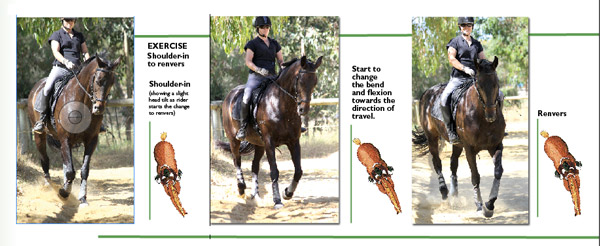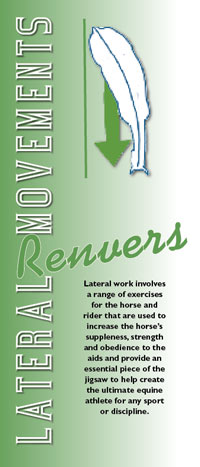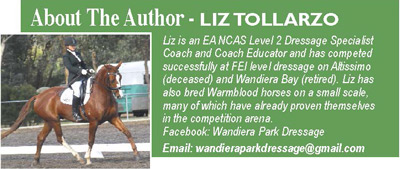

| |
Lateral work involves a range of exercises for the horse and rider that are used to increase the horse’s suppleness, strength and obedience to the aids and provide an essential piece of the jigsaw to help create the ultimate equine athlete for any sport or discipline.The horse has been a means of transport, equine companion and friend to man since time began. With good horsemanship and a managed diet horses have thrived, yet are still susceptible to a range of common conditions and ailments.
However, with the advent of the new sciences of genomics and nutrigenomics, the way of feeding and managing equine nutrition could be about to change forever. |
| |
|
Lateral work exercises can start with a simple moving forward and sideways from the rider’s leg, perhaps in the form of a turn on the forehand or basic leg yield, later developing into shoulder-in and travers – the horse is further suppled by introducing renvers.
What is Renvers?
Travers (see Feb/March 14 Vol 35 no 5) or ‘hindquarters in’ is when the horse’s forelegs travel on the outside track nearest the wall, and the hind legs travel on an inner track with the horse bent and flexed in the direction of the movement. The inverse position to this would be where the horse’s forelegs travel on the inner track, and the hind legs travelling on the outside track nearest the wall whilst the horse continues to bend and flex in the direction of movement – this is renvers or ‘hindquarters out’!
As in travers, the horse will travel on four equal tracks, with both the forelegs and hind legs crossing at an angle of approximately thirty five degrees to the wall, with the horse bent and flexed towards the direction of travel.
Why teach Renvers?
As renvers is simply the opposite position to travers – what makes it different or even desirable to ride? As there is no support from the wall and no visable track that encourages the horse to follow – this movement is much more difficult to perform smoothly and thoroughly tests the horse’s obedience to the rider’s outside aids. Travers and renvers pave the way to the half pass!
Where is it used?
In dressage tests, renvers is only asked for in the Elementary 3.3 where it is performed from a shoulder-in and continued for thirty metres in a collected trot, then the horse is ridden straight.
Before Starting!
It is very important that the horse and rider are proficient at shoulder-in and have a very good understanding and ability to perform travers. Renvers is at first, very difficult to get into and it can be rather confusing to the rider starting out. Watching another rider performing renvers or by using video showing this being ridden, will help riders who are new to this movement.
How to do it?
First taught at walk and then later at trot, renvers can then be performed at the collected canter when riding in counter-canter (cantering deliberately on the wrong leg). If riding travers or renvers at canter it is important that the rider is very careful to ride the horse straight forwards, after completion of the exercise, with periods of cantering in shoulder-fore, so as to not encourage the natural tendency of the horse to canter with its hindquarters in.
The aids for renvers are identical to that of travers however the new challenge is how to place the horse to begin the renver exercise!
Positioning before Renvers
The most common way is for the rider to start a shoulder-in on the long side of the school. Once the shoulder-in is correct the rider starts to change their weight, leg and rein aids to alter the bend and flexion towards the direction of travel. The horse’s hind legs must remain travelling down the track whilst the forlegs are on an inner track, however with the change of bend also comes a change of angle – with the shoulder-in being on three tracks and renvers on four tracks. From a shoulder-in position, the rider starts to gently flex and change the bend of the horse with the new inside rein (inside rein is always the one on the inside of the bend), at the same time the new outside rein comes a little forward before limiting the amount of bend and being ready to prevent the forehand drifting back to the track. The rider focuses on transferring more weight onto the new inside seat bone as the leg position is altered. The new inside leg moves forward close to the girth and is ideally passive to encourage the horse to bend around it (yet ready to be applied should there not be enough bend). The new outside leg is active as it moves behind the girth to maintain the forward – sideways movement and assist in the bending around the inside leg.
Another way is for the rider to first travel straight on the inside track, then move the horse’s hindquarters out onto the outside track whilst asking for the change of bend towards the direction of the movement to commence the renvers. A similar technique is to ride a shallow loop and as the forehand moves off the track to follow the loop, the rider changes the bend and continues in renvers. A more advanced exercise is to ride a turn on the haunches or pirouette at walk (or canter) and at the end of the movement, the rider asks for the renvers at the last stride before finishing the pirouette.
Remember the angle is not important to start with, ask for little bend and angle and only increase it over time. To finish the renvers movement, the forehand is bought back to the track before being ridden forward and straight.
Problems?
Getting into the renvers would be the hardest problem for most riders. Control of the horse’s shoulders needs to be very effective to be able to change the bend and flexion without the horse just heading back towards the track. Practicing shoulder-in and even a ‘leg yield’ in a shoulder-in type position will assist the setting up for the renvers. The rider must be able to sit correctly and use his/her aids independently and have a good understanding of what renvers should look like before attempting it.
If whilst changing into the renvers the horse does travel back to the track with little or no angle, the rider must again bring the shoulders in before attempting again. If the horse’s paces deteriorate, then the horse must be straightened and ridden forward as with all movements – especially lateral exercises - the horse’s paces must never be compromised. Although initially the pace may be a little slower than ideal, this will improve as the horse gains confidence and suppleness. Always be ready to go back a step if there are problems, for example if attempting renvers in the trot, then the horse should be bought back to a walk until it is again confident and sure of the aids. Once the rider is sure the horse is not confused or finding the exercise too difficult, the renvers can be attempted once again in trot.
The opposite problem is too much angle, this often is associated with little bend and flexion. This is normally due to a lack of forward movement– whether the horse is avoiding the bend, contact with the outside rein or over-reacting to the driving outside leg. The rider needs to have someone assist as ‘eyes on the ground’ or use video to assist with working out what needs to be done. Travers could also be used to trouble-shoot and if this can be carried out without difficulty, then this would point towards the rider’s aids, feel or timing being the issue.
Insufficient angle but with too much bend in the neck is another common problem where the rider is using too much inside rein or may be even crossing the inside hand across the neck (which also would encourage the horse to tilt).
A very common problem that is likely when practising travers, renvers or later half pass, is that the horse canters instead of trotting. This may simply be a misunderstanding or it could be an evasion – in either case the rider must continue with the original aids whether it is still cantering or not, and when the horse comes back to the trot it should be rewarded with neutral aids, allowed to straighten out of the movement and praised before once again asking for the renvers (or other lateral exercise). If the aids for the renvers is removed when the horse canters, the horse is then rewarded for the canter and this same response will be repeated over and over until the above correction is undertaken. As with any problem, the more times the horse is allowed to perform a movement incorrectly, the harder it is to fix.
By practising travers and renvers the rider continues the path towards improving the horse’s physical and mental development and increasing its suppleness, both by developing the lateral bend throughout the horse’s spine and the necessary muscling and development that this work encourages.
Next – the half pass!

|